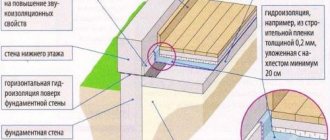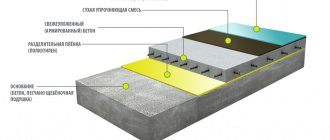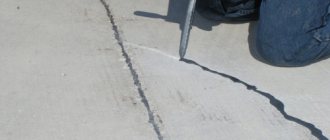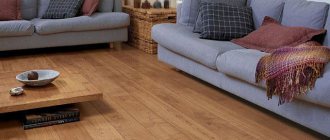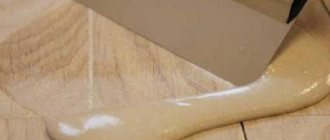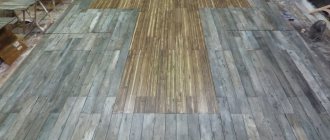Scope of application
The high reliability and wear resistance of the diamond cup make it unrivaled among other equipment for processing hard materials. Using the nozzle, concrete, brickwork, stone slabs, porcelain tiles, and paving slabs are scraped and polished. Diamond discs are widely used for polishing natural stone - marble or granite. Operations performed using discs include rough, profiled and finishing grinding operations. Diamond cups are used for the following purposes:
- removal of screed sagging;
- roughening;
- alignment of seams;
- grinding joints;
- surface cleaning;
- removal of old or protruding layer;
- final polishing.
When installing attachments on an angle grinder, a dust extractor is usually used or the surface to be treated is moistened with water (wet grinding). This will help reduce dust and make cleaning easier.
Concrete grinding discs are widely used during dismantling work. They effectively remove layers of used glue, hard-to-remove coatings (epoxy, plaster, plaster) and have a long service life. Grinding with a diamond cup saves time: it not only removes unnecessary layers, but also immediately levels the surface.
Design features
Cups for concrete are made of hardened steel with fused small fractions of diamonds. The nozzle is a product consisting of the following elements:
- Round concave base with elements for installation on high-speed electric tools.
- A grinding wheel for concrete, on which segments with diamond fractions are fused.
The bowl-shaped base has holes for cooling during operation. Diamond cutters are located in a circle on the working circumference of the disk, separated by certain intervals (slots). The slots also help cool the cup with air and, in the case of wet processing, with water.
Main characteristics
Attachments for grinders vary in size. The most popular standard cup diameter is 125 mm. Other options include diameters from 110 to 180 mm. The power of the tool used to work with the cup must be at least 1500 W. Large nozzles significantly speed up surface treatment, but their cost is higher and they require the use of a more powerful unit. Small-sized products are used by engravers to process workpieces. The diameter of the mounting hole located at the base of the cup varies from 19 to 22.2 mm.
In accordance with GOST, the diameter of the mounting hole varies from 19 to 22.2 mm. The mounting hole must match the tool that is intended to be used. A loose cup fit can lead to injury and rapid wear of the diamond layer. But usually the attachment kit includes an adapter ring that allows you to use them with tools of different diameters.
All diamond grinding discs for concrete have special markings. It reflects the main characteristics in the following sequence:
- diameter of the outer circle (for example, 125);
- cup depth (40);
- working surface width (10);
- segment height (3);
- mounting hole (22).
All parameters are indicated in millimeters. The brand of diamond powder and the diamond content are specified separately. As a rule, it is 100%, but it can be less or more. Particular attention should be paid to the grain size (for example, 125/100 microns). Large fractions are suitable for rough grinding and roughing work, small fractions are suitable for fine polishing.
The nozzle is selected to match the existing tool. The maximum permissible rotation speed of the disk must correspond to that of an angle grinder, since the safety of work depends on this. Each type of diamond cup has rotation speed restrictions. For example, for double-row cups it is 13,300 rpm.
Preparing for work
In order to determine which sanding technology suits you best, you need to carry out test work on a small area of the floor. Also ground all electrical devices in the room to avoid an unpleasant surprise in the form of an electric shock.
It happens that a more careful examination of the floor gives disappointing results about a larger number of irregularities and their sizes. But there is nothing fatal in this situation. Just take another grinding wheel, making sure that the size of the cutters on it is larger.
The screed for further work must be laid at least half a month in advance. During approximately this time, it has time to dry completely and can be processed much more simply and easily. Please note that a screed that is not completely dry can result in crushed stone being swept out of the concrete mass.
Purpose of an angle grinder
A grinder, or officially an angle grinder, is an almost universal tool that allows you to perform many operations:
- surface grinding;
- cutting materials;
- cleaning;
- polishing
The main distinctive feature of the angle grinder is the method of installing the spindle, which is installed at an angle to the body. This design allows you to effectively use hand tools as real professional equipment. A variety of materials can be processed with a grinder: wood, stone, brick and concrete.
Features of grinding work
Diamond, as the hardest substance, effectively copes with the most difficult jobs of cleaning and grinding concrete screeds. To perform surface treatment, a diamond alloy cup is attached to the spindle of an angle grinder (grinder). The rotational motion that is transmitted to the disk is approximately 11,000 revolutions per minute. The high power of the tool on which the diamond concrete grinding cup is mounted also increases the productivity of the disc itself.
When working with hard surfaces, consider the following guidelines:
- The correct choice of nozzle in accordance with its purpose will greatly facilitate the processing of concrete.
- Before finishing grinding, rough grinding of edges and sagging is carried out to reduce the load on the disc.
- To break in the cup, it is necessary to carefully break it in in a gentle mode during the first few meters.
- The grinder should be held firmly with both hands to prevent impacts, especially when removing rough protruding defects.
- During operation, the cutter is pressed against the surface, but without increased pressure.
- Do not grind surfaces with breaks or cracks.
- To self-clean the nozzle, effectively cool it and reduce dust formation, it is recommended to supply water to the screed being treated.
- It is strictly not recommended to carry out work during frequent power outages or using faulty tools.
To avoid injury during work, you should use closed shoes made of thick, durable material. Compliance with these simple recommendations will ensure safety during work and extend the life of the diamond cup for construction concrete for an angle grinder.
The grinder is a universal tool with a wide range of capabilities. Their implementation requires special equipment. Among its types is a diamond cup for concrete for a grinder, which is used to clean and polish floors and walls.
Attachments and discs for concrete for grinders
Each tool used in conjunction with an angle grinder (angle grinder) is designed to perform the operations for which it is designed. The correct choice contributes to efficient and safe work with discs and attachments.
Cutting discs
Diamond cutting wheels are used to work with concrete. These are discs made of durable hardened steel with diamond coating on the cutting part.
These nozzles differ in the following design features:
- Cutting edge. It can be solid or with various slots. Segmentation increases the efficiency of air cooling during operation.
- The grain size of the diamond coating and the spraying method. The most reliable methods using laser welding and thermal bonding. Silver soldering allows operation with water cooling only. The electroplated diamond edge cuts only soft natural stones.
- The outer diameter of the circle. The correct size disks must be installed. Working without a protective cover is not only dangerous: the increased size of the nozzle leads to premature wear of the gearbox.
Diamond cutting can only cut material in a straight line. Curved sawing increases the load on the cutting edge, causing the diamonds to break.
Grinding discs for concrete
Concrete is ground to eliminate coating defects. Diamond wheels are used, which have a high abrasive ability and a long working life. Sometimes hard-alloy coated disks, the characteristics of which are lower, are called diamond. The efficiency of work is determined largely by the grain size of the working surface.
Depending on the concentration of diamonds, discs for grinding concrete are distinguished:
- with grain size 40-80 (for pre-treatment);
- with indicators 100-120 (for leveling the surface);
- with grit 180-240 (for polishing).
The tool is a steel circle with soldered segments. Diamond powder is fixed to them with a special bond. It keeps the diamonds from being destroyed by the centrifugal force that occurs during rotation.
The designations on the discs consist of 2 or 3 numbers. The first number indicates the outer diameter, the second indicates the size of the mounting hole. The third number is not always present; it indicates thickness. For a grinding tool, this parameter does not play a big role.
Cleaning and roughening attachments
These attachments look like cups or circles. There are cutters and diamond discs. Twisted metal brushes are located around the circumference of the rollers. They strip metal and stone. The diameter of the wire varies depending on the purpose (scraping or stripping).
The working part of the diamond grinding disc has cutting edges. It is not used for stripping metal: it is used to clean stone, concrete, and remove hardened cement mortar.
Purpose of an angle grinder
The peculiarity of the machine is its ability to process not only smooth surfaces, but also chamfers. This is achieved thanks to the angular placement of the working disk.
The device is universal and can be used to perform many jobs:
- The main operation for which an angle grinder is intended is grinding. Wide grinding wheels are used. Processing the ends with an eccentric grinder is difficult, but it is accessible for an angle grinder. The surface is ground with or without water cooling.
- Polishing with a grinder is also possible. To do this, use special diamond-coated polishing discs.
- Another operation that is performed with a grinder is res. The unit is not suitable for working with thick materials. Concrete or thick stone should be cut with special machines that have a water-cooled working wheel.
- An angle grinder easily cleans surfaces, removing dirt, paint, mastics, adhesives, and construction mixtures using abrasive attachments.
A grinder can be used instead of a wall chaser. A cutting disc is used to cut grooves for electrical cables and pipelines.
Cost of grinding concrete floors
Concrete surfaces can be made of concrete of different grades, with different fillers, of different ages and different qualities. The price per square meter for concrete grinding greatly depends on these parameters.
Estimated prices for grinding concrete floors:
| Rough grinding of concrete using a tool with a large diamond grain (Used for grinding poorly leveled surfaces or for high-grade concrete) | from 180 RUR/m2 |
| Final grinding of concrete using a fine diamond grit tool (Used after rough grinding or on well-leveled surfaces) | from 140 RUR/m2 |
| Polishing concrete with an abrasive tool (After grinding with milling cutters, use an abrasive tool to add gloss) | from 110 RUR/m2 |
| Sanding high grade concrete floors | from 230 RUR/m2 |
| Grinding concrete stairs | from 800 RUR/m2 |
| Grinding concrete tiles | from 450 RUR/m2 |
| Leveling concrete floors | from 620 RUR/m2 |
What is a diamond cup
To prepare for applying the next layer or final finishing of the coating, the screed is ground and polished. At the same time, uneven surfaces are removed and cracks are smoothed out. The ultra-hard working surface of the equipment - a diamond cup for concrete - easily removes the top layer.
Design Features
The nozzle has a round concave base on which a grinding wheel is attached. Its working part is divided into segments with small diamonds attached.
The bowl-like base has holes that help cool the tool during use. Between the segments there are spaces left - slots. They help cool the tool and material with air and water.
There is a hole in the center of the cup through which it is threaded through the grinder spindle and screwed with a nut. Some models have a thread in the hole, so the tool is screwed onto a shaft.
Main characteristics
The diameter of the cups is standard: 110-180 mm, the most popular is 125 mm. The grinder engine must have a power of at least 1.5 kW. Large nozzles work faster, but they are more expensive - a more powerful machine is required. The mounting hole for use with a standard size grinder is 22.2 mm.
Small diamond fractions are fixed on a steel base. The mixture is pressed, which makes it especially strong. Mills with large grains (200/160 microns, 160/125 microns) are used for stripping and rough processing of surfaces. Finishing is carried out with diamond-coated nozzles of small and medium fractions: 125/100 microns, 100/80 microns.
Where can I order concrete grinding?
We recommend contacting. Grinding a concrete surface or floor made of other materials will be done quickly and in compliance with the nuances of the technology. We carry out the work efficiently: we use powerful equipment and proven consumables. The price of services is affordable. In addition, we provide each client who contacts us again with a 5% discount. Leave a request via the online form or by phone, and we will get to work as soon as possible.
Book your cleaning now!
« Return to list of articles
Types of Diamond Cups
Attachments for grinding concrete using an angle grinder are classified depending on the manufacturing method.
- with a single-row working surface;
- double row;
- solid.
Single-row equipment has good performance and low weight. It is used to polish concrete and create a smooth edge. The disadvantage is that the tool is difficult to hold on the surface.
Double-row cups are used to carry out primary processing and eliminate gross defects in the concrete screed. Surfaces are polished using nozzles with continuous coating.
Innovation in grinding
The development of technology does not stand still; every day things appear on the market that make life and work easier. The topic of concrete grinding has also not been ignored by technological innovations, so now craftsmen have such a device as a concrete grinding machine.
This item does not require any special knowledge from the builder. The principle of its operation is simple - turn it on and start processing the surfaces. However, despite the apparent simplicity and ease of handling this item, it is worth considering the disadvantages, such as the need to constantly spend money on consumables and fine dust raised by devices.
However, the first part of these problems can be solved by choosing to rent a car instead of buying a car, since such services are quite widely represented on the market. The second question can be partially resolved by using safety glasses and a respirator. They will save you, if not from dirt, then from unpleasant injuries to delicate mucous membranes.
Shape and number of segments
The number and shape of segments vary depending on the conditions and the required quality of work. They are also positioned differently, which affects the working properties of the nozzles.
Double segment
Diamond cups with double-row segments eliminate large defects in concrete. They easily cope with large sagging and protruding seams. They can reduce the thickness of the screed. The surface after processing is rough, finishing grinding is carried out with a different attachment.
Boomerang
The shape of the segments resembles the weapons of the Australian aborigines, which is why the cups got their name. These are diamonds of the finest fraction, which determines the purpose of the attachments - finishing grinding. Thanks to it, the screed acquires a mirror-like evenness. Light weight and balance make it possible to use the Boomerang with an angle grinder. The equipment is stable and soft in operation.
Square
Square incisors of increased thickness are located at a distance from each other. This allows you to remove protrusions on the concrete and level the surface. The weight of the disc is large, which helps in work. Powerful segments cut off unnecessary elements. Rough processing is used to prepare for subsequent operations. It leaves behind a rough surface with good adhesion, which requires coating with different compounds.
Turbo and Typhoon
"Typhoon" is used for peeling and grinding ultra-dense and hard materials. High wear resistance of the segments increases the service life. "Turbo" is used for high quality grinding. Nozzles of this type are used for processing chamfers, edges, bends, and engraving work.
The cutters of both attachments are located perpendicular to the rotation. The slots between them are of minimal size, making the working surface almost continuous.
Existing types of grinding
The concrete surface is ground dry or wet. For this, the same equipment is always used, because the tool must cope with the processing of stone or concrete.
The dry grinding method is best used for cement-sand screed. The process takes longer than the wet method. During operation, grinding equipment generates a lot of dust. Vacuum cleaners are used to remove it, but they completely fail to cope with the task and some of the dust still rises into the air. The advantage of the dry method is good visibility of the work, so all errors can be corrected immediately.
The wet grinding method is usually used for concrete floors with the addition of marble chips or mosaic coating. The tool used in the work with abrasive segments forms a smooth surface, no different from a polished floor. To remove waste wet dust, special equipment is used - water pumps, but still most of it rises into the air and clogs the worker’s eyes.
Features of choosing grinding cups
When choosing a tool, consider:
- Type of planned work. For each operation, special attachments are most effective. Using the wrong ones slows down the work or makes the process impossible, and quality suffers.
- The diameter of the cup, which should correspond to the power of the grinder. For accurate sanding of small areas, small attachments are more suitable. It is faster to work with large equipment, but its price is higher.
- Mounting hole, which must correspond to the size of the shaft. If the tool spindle is thinner, an O-ring is used: the fit on the shaft cannot be loose.
- The discs are designed for a rotation speed that the grinder cannot exceed.
The diamond grinding tool is marked with a marking that reflects:
- external diameter;
- cup depth;
- working edge width;
- segment height;
- mounting hole size.
Numbers in millimeters indicate characteristics in the sequence given above. The spraying parameters are indicated separately: diamond content in percentage, grain size in micrometers (µm). Coarse diamond powder is suitable for roughing and rough grinding; fine diamond powder is used for polishing.
Grinding technology
The work is carried out using a dry or wet method. Wet grinding, which is close in quality to polishing, is used for processing concrete and products made from marble chips. The process is accompanied by the formation of sludge from wet dust.
The dry method is used for grinding concrete, which produces a lot of dust. The method is effective if you use high-quality nozzles.
Surface preparation
The quality of grinding and the service life of concrete depend on surface preparation. They start by dismantling the old coating, if any. Milling, shot blasting or diamond grinding discs are used. After this, grooves often form, which are removed by long grinding.
Surface preparation also includes the following work:
- Check the strength of the concrete base by tapping it with a hammer. If voids are found, the areas are opened and filled again.
- Check whether reinforcement elements or mesh are exposed to the surface. When they are discovered, a depression is made around it, which is then sealed, and the metal is cut off.
- Small irregularities, seams, cracks are eliminated with epoxy mastic. It grinds well, but the consumption of nozzles is greater.
- Then they check the plane by applying a 3 m long ruler to the surface. Holes and potholes are marked so that they can be repaired later; low bumps will be cut off with a diamond tool. All irregularities affect the wear of the cup.
- If necessary, concrete drilling and other similar work is carried out.
Large cracks and seams are expanded using a circle to a depth of 10 cm. They are freed from dust, primed, and sealed with mortar. A good filler for the repair mixture is river sand. When the first layer has sagged, apply a second one and level it out. The frozen surface is polished.
Repairing Potholes
On the old coating, due to mechanical wear, depressions form, and raised areas appear nearby. When preparing the surface, these places are found using a ruler. If the differences exceed 5 mm, the screed is leveled. To do this, around the pothole, a “grinder” with a diamond disk is used to cut out the damaged area to a depth of at least 20 mm. The concrete is broken up with a hammer drill and the material is removed.
The cavity is cleaned of dust using a vacuum cleaner or sandblaster. Next, it is treated with a primer and filled with a building compound, which is used to seal irregularities. If the depression is large, the mixture is applied in several stages. The surface is leveled and sanded after hardening. Cracks may form in the area where the pothole has been repaired; these should be repaired.
What is needed to complete the work
To work with polishing you will need special equipment:
- grinding machine with a number of attachments;
- tools for milling, made of hard alloys;
- brushes trimmed with corundum;
- Bulgarian;
- special eye protection glasses;
- A respirator is absolutely necessary to protect against small, unpleasant concrete chips rising into the air.
Stylish base
If necessary, before starting work, the surface is thoroughly cleaned of any remaining varnish or paint. Minor defects and simply uneven places are also removed in advance. If a pronounced wave is visible on the surface, its mechanical removal may take too much time. Such a nuisance will have to be eliminated by pouring an additional layer.


